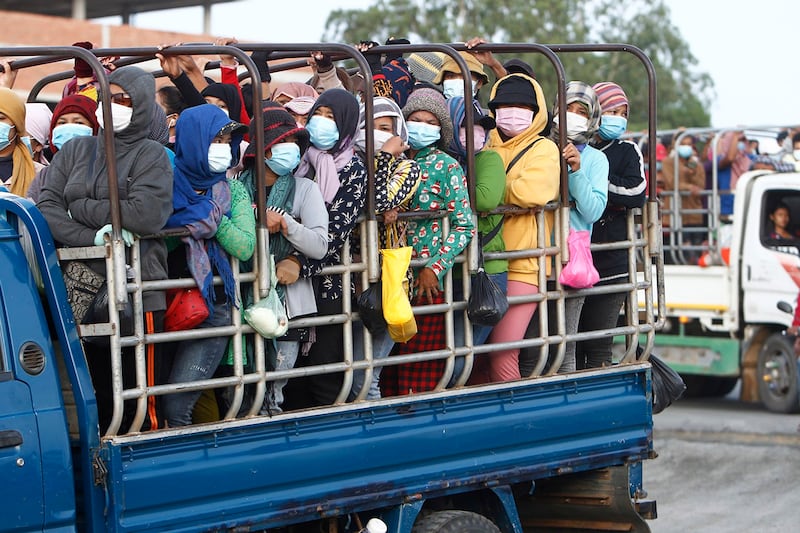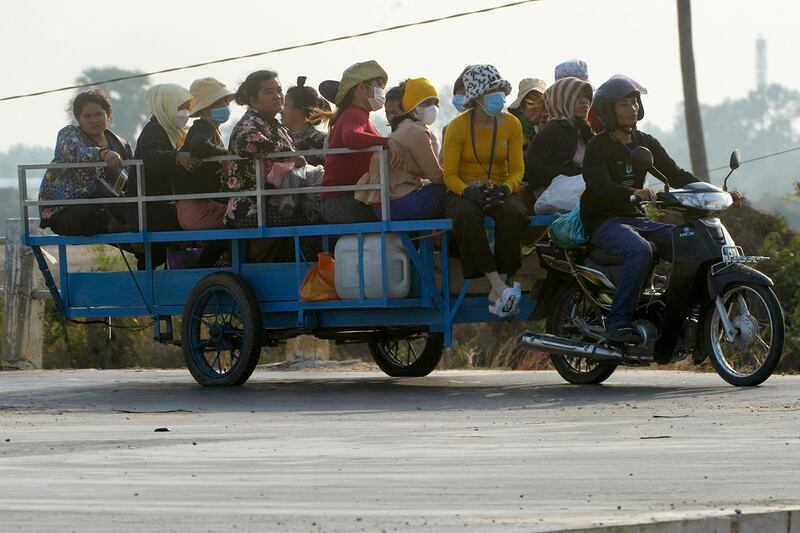On Wednesday, two garment factory workers were killed and 25 injured in Cambodia’s Preah Sihanouk province when the minivan they were traveling in was hit by a cargo truck. The truck, trying to overtake another vehicle, hit the van in a head-on collision.
Had the van been carrying a standard number of passengers, about 15 would have been seated inside. Instead, police photos show a poorly retrofitted vehicle where seats and seatbelts had been replaced with a pair of long, makeshift benches lining the length of the van. A third bench was bolted to a platform extending from the van — its trunk held permanently open by metal bars. In this manner, the minivan could hold more than two dozen passengers.
The model is just one among several dangerous yet standard forms of transport used by Cambodian garment workers. Many travel standing shoulder-to-shoulder on the flatbeds of cargo trucks, where scores of workers are packed so tightly it’s hard to move. Others pack in on open trailers hitched to the back of motorcycles.
It’s little wonder, then, that garment workers routinely die in traffic crashes. In 2022, 63 factory workers were killed and more than 3,900 injured, according to the most recent figures available from the AIP Foundation, a regional road safety group.
“We know that in some cases, a small van can carry only 10 people, but they converted it to transport 30 to 40 people,” said Ath Thorn, vice president of the Coalition of Cambodian Apparel Workers' Democratic Union.

Why do workers travel this way?
Garment factories are a cornerstone of the Cambodian economy, employing more than 830,000 workers and making up about one-third of the country’s gross domestic product. Despite their importance to the economy, many workers face poor factory conditions and extremely low salaries. The current minimum wage for factory workers is $204 a month, a figure that labor advocates say is far below a living wage. (Unions have been pushing for a $218 monthly minimum wage as 2025 negotiations begin among workers, factories and the government, but the industry has so far only offered $1 more.)
The average monthly cost of traveling via crammed flatbed truck — the cheapest means of travel — is about $12, according to the Southeast Asia Globe. While factories are mandated to pay a $7 a month transportation allowance, the amount has not risen since at least 2015 and is far below what would be needed to travel safely. Public transportation is virtually nonexistent in Cambodia, and safer means of transportation cost much more than most workers can afford.
While a handful of factories provide transportation, the effort is ad hoc and comes with its own complications. As a result, most workers have no choice but to continue piling into vehicles jerry-rigged to carry as many passengers as possible — despite the dangers.
Is this problem unique to Cambodia?
Commutes are often a leading cause of workplace accidents in places with high concentrations of garment workers and poor road safety records. Road safety has plagued neighboring Vietnam’s garment sector, where the road crash rate is nearly twice as high inside industrial zones, according to research from AIP. A key difference in Vietnam, however, is that 87% of workers travel via motorcycle — meaning the type of mass casualties accidents common in Cambodia are virtually non existent. In Bangladesh, which has the second-largest garment sector after China, it is mostly pedestrians who are killed in road accidents involving garment workers.
Is there any solution?
For decades, Cambodian workers have struggled with the same road safety issues. A 2005 International Labor Organization report on employment insurance cited commuter traffic accidents as one of the chief causes of workplace injury. While the means of transport is clearly the chief contributor to accidents, poor roads, bad driving, and inadequate licensing and driver education have made such accidents even more likely.

Unions, rights groups and workers have long pushed for reform, but the problem has proved fairly intractable. With the garment industry refusing to foot the bill of worker transport, cracking down on the so-called cage trucks or other means of unregulated transport is hardly a viable option for the government. Doing so would simply make it impossible for most workers to clock in.
There has been attention of late, however, with a government social security official saying the government will be phasing out flatbed trucks by 2027. Last year, Labor Minister Heng Sour promised safe transport for workers by 2027. But Ath Thorn, the unionist, said there had been little notable progress since.
“Employers talk about the $7 contribution, but the workers say that it is not enough because they have to pay $10 or $20 a month,” he said. “As for the state, I do not see any program to help other than to encourage employers to provide funding, and the state does not have any specific program.”
A Ministry of Labor spokesperson could not be reached for comment.
Edited by Jim Snyder.
